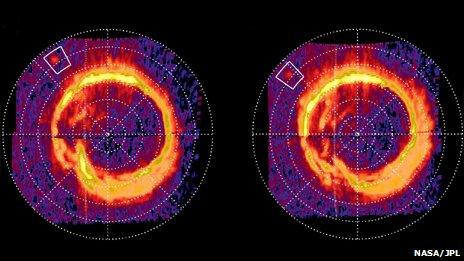Aurora from Saturn moon 'circuit'
- Published

Saturn enjoys a flickering "Northern Lights" phenomenon thanks to a flow of electrons to and from its moon Enceladus, researchers say.
A report in Nature suggests these aurora would be faint, and in the ultraviolet part of the light spectrum.
The find by the Cassini spacecraft is similar to the electrical "circuit" between Jupiter and three of its moons.
Electrons flow to and from Enceladus' poles in a vast loop, and aurora result where they hit Saturn's magnetic field.
The aurora creation process is similar to that which happens at high latitudes on Earth; here, the paths of fast-moving charged particles from the solar wind are curved by the Earth's magnetic field and emit the displays we know as the Northern and Southern lights.
In contrast, the fields created by Jupiter and Saturn envelop the planets' moons, and what is known as electrodynamic coupling brings particles directly from the moons, completing what is actually an electrical circuit.
The mechanism behind Jupiter's aurora is presumed to be sulphur from its moon Io's volcanic activity, split by sunlight into electrons and ions.
On Saturn's moon Enceladus, however, the suspected source of electrons is "cryovolcanism" - volcanic activity that shoots up liquids or, in Enceladus' case, salty ice.
'Rare opportunity'
The Cassini spacecraft has been studying Saturn and its moons since it arrived in 2004, having made 12 close passes of Enceladus.
On the close encounter that occurred on 11 August 2008, scientists detected a great stream of ions (molecules with electrons removed) coming from the moon.
Lead author of the study Abigail Rymer of Johns Hopkins University confirmed that the ions were associated with the vast electron loops.
"I immediately pulled up the electron data and, sure enough, there was a very strong electron beam propagating away from Saturn toward Enceladus," Dr Rymer said.
"It was actually a fairly rare opportunity to capture that, since when Cassini flies close to a moon we are generally looking at the moon -- not away from it."
The team was able to collect images of the point where the loops re-enter Saturn's magnetic field, interacting with it to form aurora.
"I think it's a very exciting, very interesting discovery," said Andrew Coates, a co-author of the paper from University College London.
"Five or six years ago we didn't know that Enceladus was putting any material into the Solar System - now we get exciting effects like these magnetic and electric current links into the ionosphere of Saturn, producing this (aurora) spot," he told BBC News.
The team says that the aurora are about a tenth the intensity of those seen on Jupiter, and that they vary widely in intensity - by as much as a factor of three.
That, they assume, is down to variations in the output of the geysers that are feeding the process - a process that Professor Coates says seems likely to be happening elsewhere.
"It's probably a universal process; it could be something that's happening in other places like [Neptune's moon] Triton, or extrasolar planets where there are 'hot Jupiters'."
- Published31 March 2011
- Published12 April 2001
- Published3 February 2010
- Published8 February 2010
- Published23 November 2009
- Published16 December 2008
- Published8 February 2007
- Published18 July 2005